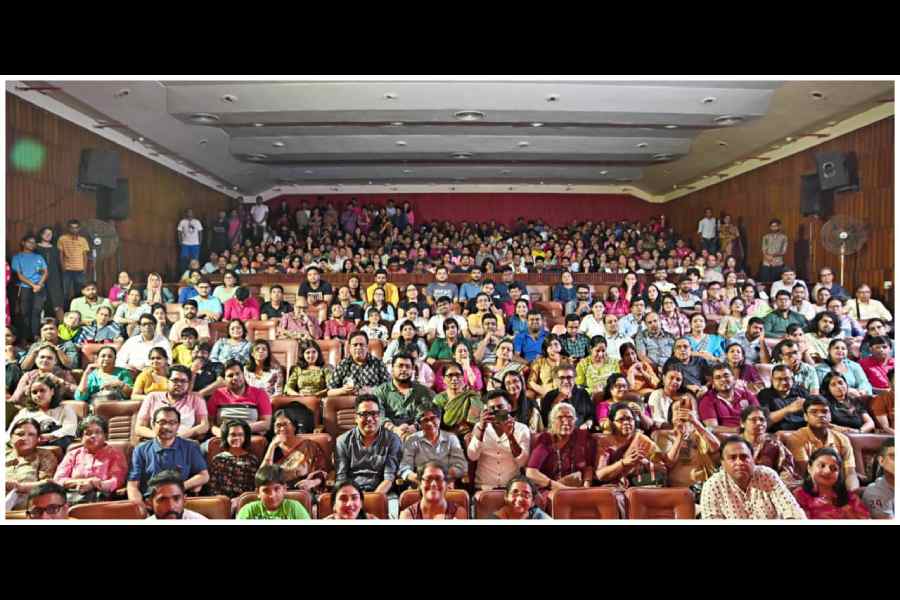If one makes a character sketch of Calcutta, theatre will unequivocally be found in the pith of this city’s soul and will always find a mention in what forms its ethos across generations. People’s time-tested passion towards this art form remains to this day.
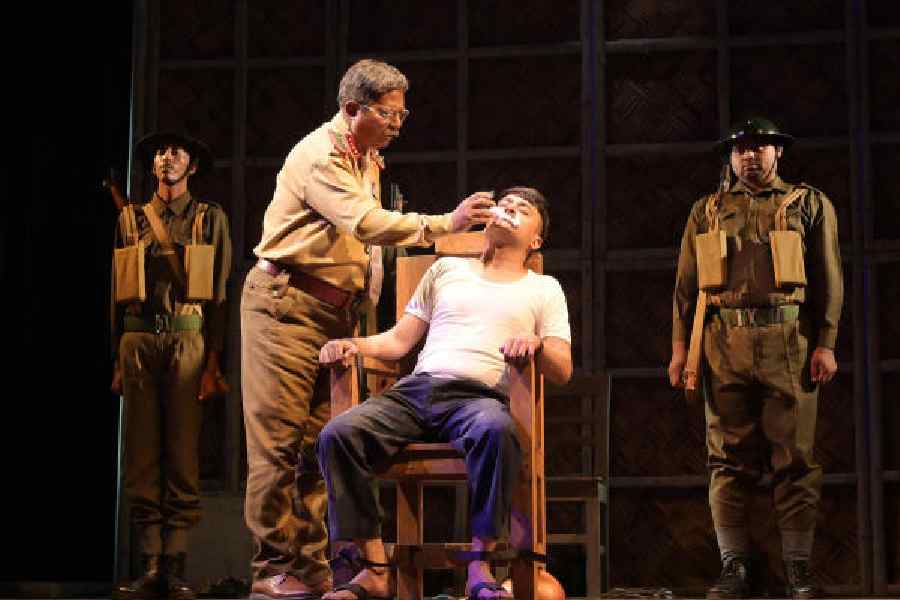
Chandan Sen in Delhi Cholo at Academy of Fine Arts
This year, theatre practitioners in Calcutta are celebrating the 75th year of group theatre and the 150th year of public theatre in this city. However, both the celebratory years and the specific terms — ‘group’ and ‘public’ — used to define this art form are debatable even within the theatre community. But what is anecdotally evident is that theatre has renewed its pull and plays are being staged to full or near-full houses. So what is driving this phenomenon for proscenium theatre?
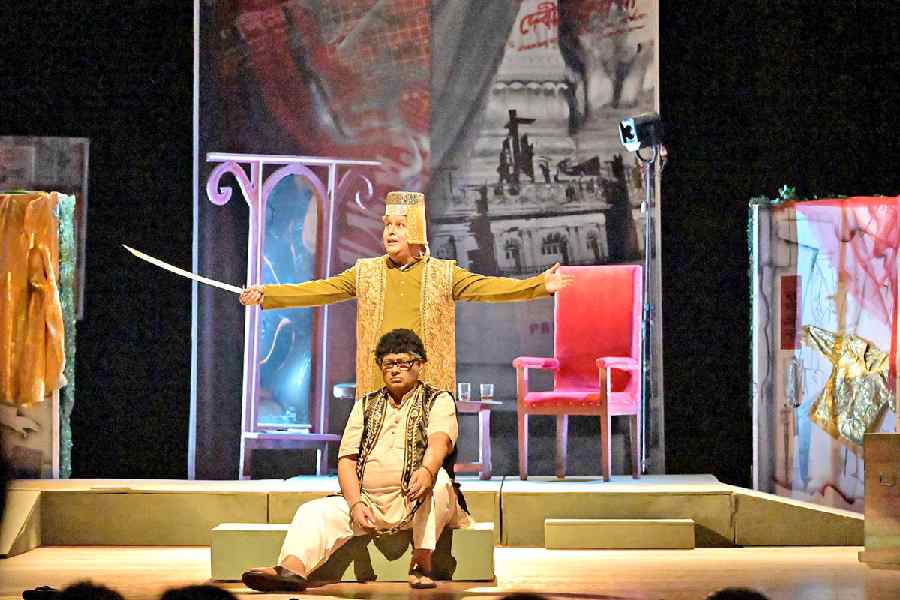
A scene from Suman Mukhopadhyay’s play Ajker Shahjahan at Girish Mancha, where Shankar Chakraborty plays the protagonist Kunjabihari
FLOCKING TO THE THEATRES
Actor Chandan Sen, who started his journey in theatre independently in 1979, relates people’s love for theatre to a basic instinct of human nature. “Men cannot live alone. It is their tendency to live along with others. The contemporary hegemony of the culture right now is of a corporate culture that will always try to make everyone feel unique and tell them they are alone and selfish, because they want to sell their products — three TVs in one house! But that, in fact, is not true with regards to human nature. Theatre’s history goes back to the hunting age. It is a living art that people want to watch live,” explained Sen.
Veteran theatre personality Debshankar Halder said: “Theatre’s strength or weakness is it needs to be done by coming in front of people and establishing direct communication. Probably after Covid, people wanted to experience this direct communication even better so they are coming to theatres. When something becomes popular, people let others know and they also come. But this cycle of rise and fall of the audience in theatres has been happening for a long time. It is not just about before-and-after pandemic. We have done many housefull shows before also.”
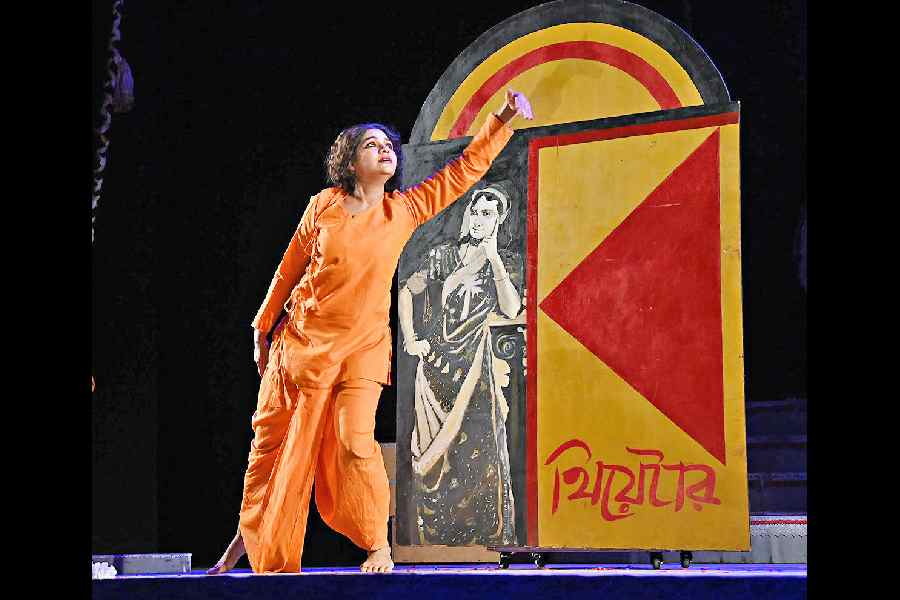
Sudipta Chakraborty in Binodini Opera
Director Kamaleswar Mukherjee felt that the “numbers” probably have not really increased a great deal. Unlike cinema, where scaling up the size of the audience today is just a matter of streaming the digital content to more movie halls or any other digital screen, theatre is limited in terms of scalability since one group can stage only one show at a time.
Koushik Sen, one of the four founding members of the group Swapnasandhani, reminded us how pandemic made a certain section of the theatre practioners think of digitalising this art form. “I was never interested. I always felt without that live experience theatre will have no meaning. Even before people started watching Bengali films in the halls, they started coming to theatres [to watch plays], right after the pandemic,” he said.
“My parents were regular theatre goers and that’s how I got introduced to theatre, but since I was a child, I used to not understand much at that time, but the whole spectacle appeared to me as a far livelier event than watching a movie. Now, I am a regular at the theatre halls. I find it a much more immersive experience. With multiple streaming platforms, I feel, the novelty of watching a film in the halls has gone, but theatre has not lost it,” said Jai Ranjan Ram, psychiatrist and t2 columnist, whom we spotted at Swapnasandhani’s show of Hamlet.
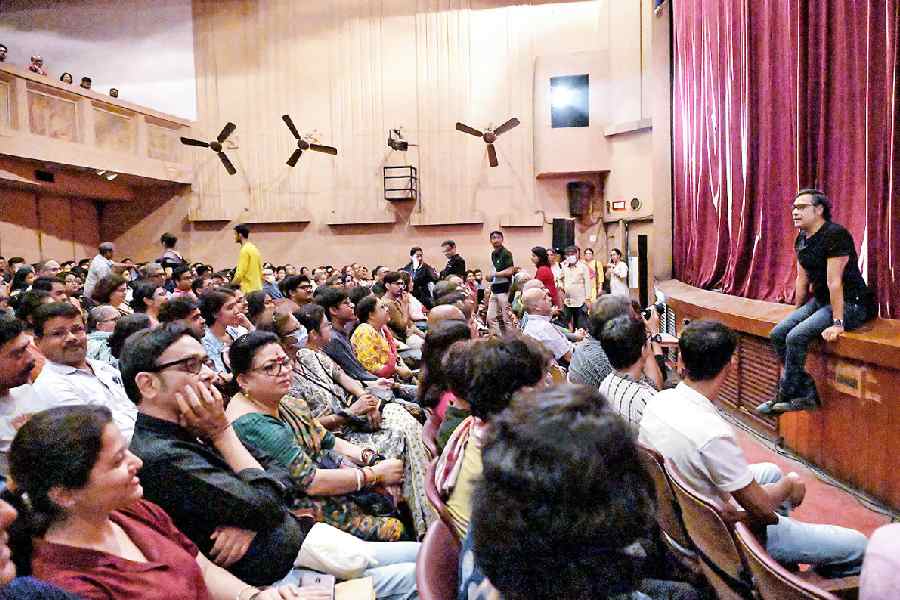
Koushik Sen addressing a house-full audience before beginning a show of Hamlet
Riddhi Sen, a younger member of Swapnasandhani, whose portrayal of Hamlet recently received critical acclaim, said: “The exclusivity of this art form, which demands a certain way of viewing, has not changed or evolved yet. So people have not found any alternative for (going to the) theatre, unlike cinema which now has an option of being a personal viewing experience rather than being a solely collective viewing experience. The art has diluted in the bulk of Bengali content and cinema being produced today so much that we can’t see today’s Calcutta, today’s Bengal, today’s socio-political world that people live in. Whereas in Bengali theatre, the content that theatre practitioners are bringing are relatable to people. That societal representation, time representation is much stronger in theatre.”
His father Koushik Sen reiterated, “Instead of group theatre I call this other theatre. Which is now the only form of mainstream theatre because the professional theatre in Bengal is no longer there. For other theatre, it was never a priority to pull people in the hall. For other theatre, it was always about doing things opposite to what is happening in the mainstream. Quality was always important for this other theatre, not how much people are coming. Word of mouth works for theatre. The present situation is quite encouraging. We have been able to create a steady audience with our flaws and faults.”
Actor Rwitobroto Mukherjee drew our attention to the role of social media in bringing in more younger audience to the theatres. “Theatre has always constructed itself over and over again from a deconstructed stage. Our group (Ashokenagar Natyaanan) will be 33 this year, Nandikar crossed 60. Such groups always have a set audience, a comparatively senior audience who has been watching theatre since a long time.
“However, there are lots of comparatively younger theatre groups in Calcutta that have an appeal. The young theatre practitioners of these groups successfully created that appeal for the younger audience, like some members of Kolkata Romroma, by bringing youth representation on stage. This happened a lot because of Facebook, we can reach out to a lot of people,” he said.
Actress Surangana, who received much praise for playing Ophelia this year in Swapnasandhani’s Hamlet, spoke about contemporary plays bringing in audience of all ages to the theatre. “In Hamlet, we have seen a large group of young audience and first-time theatre goers. It has been wonderful to see them expressing their joy. Some couldn’t belive they were missing out on this experience,” she said.
Sudipa Basu, a regular theatre goer and actress for almost 33 years, believes that the success that theatre groups are enjoying in Calcutta is restricted only to some. “Not all theatre groups can afford advertisements. Here social media is playing a big role in making people aware,” said Basu.
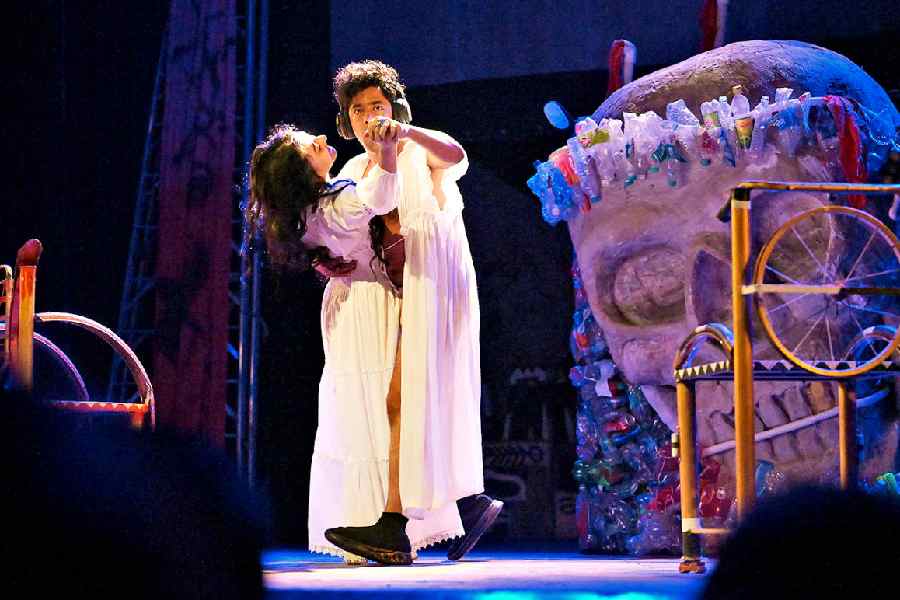
Riddhi Sen and Surangana in Swapnasandhani's Hamlet
GROUP THEATRE TODAY
The group theatre concept also has undergone changes over the years and more so in recent times, just like its audience.
“A change was already taking place, which is to work professionally. When we started working in theatre, we had to work by paying money out of our pockets. Only technicians used to get paid, not the actors. Now people are getting paid when they are coming to act. Some of them act in different groups and they can earn from that,” pointed out Shantilal Mukherjee of Ashokenagar Natyaanan.

Suman Mukhopadhyay interacting with the audience after presenting Ajker Shahjahan
Shankar Chakraborty, who acted with Utpal Dutt and whose recent comeback on stage with Suman Mukhopadhyay’s Ajker Shahjahan received tons of praise, reiterated the thought. He said: “In our times, we had to stick to our groups. But now people act in different groups. Nowadays, theatre actors are also getting chances in web series.”
Director Subhadip Chakrabarti also pointed out how getting a chance in OTT and cinema has become a strong motivation for the younger generation to join theatre. “Earlier they used to watch a lot of theatre shows, watch films, read books and listen to music. Nowadays, a big chunk of the younger generation who come to join think they will get a chance in serial and cinema if they do theatre.”
Actor and director Suman Mukhopadhyay analysed the trend: “Theatre has always been in a precarious zone from the time of advent of cinema and TV. In the Indian context, it is mostly an amateur act. The young theatre actors are getting chances in web series, so the interconnectivity happened. The spectrum of work has increased. They are all career driven, so they are steering away from mainstream theatre. They are working in small groups. This alternative movement is happening.
“Theatre cannot be a primary profession of a youngster. There was a time when people used to work in government jobs and then come and do theatre. But now work ethics have changed and that is no longer possible. I have always combined my work in different media. I never just survived on theatre. But theatre remained my first passion.”
Subhadip Chakrabarti points out how Anjan Dutt, too, recommended the same to his group during an online session — that in order to survive in theatre they must find other means of sustenance.
For Sohini Sengupta of Nandikar, “theatre is a way of life”. “Just like we have loyal audience, we have a lot of younger audience also who are coming to watch us and one of the main reasons for that is the presentation with new actors, not with ready actors or big stars. Nandikar’s tradition is to help the young generation or new actors and to create new actors,” said Sohini.
“Recently I watched Binodini Opera and even before that I watched a few great productions. I love watching theatre. But what is more special for me this year is I appeared on stage as an actor for the very first time in a psychological play for Samakalin Sanskriti,” revealed a very excited Ditipriya Roy. “Of course production design has changed a lot and in today’s time theatre actors are equally well known like their contemporaries in cinema and OTT,” she added.
THE AUDIENCE ATTRACTORS
Koushik Sen gave credits of the present success to theatre’s ability to reflect on the reality better as a form of entertainment. “If we look at the subject of Bengali films, we will realise that we are moving in a particular direction, either detectives or family drama or human relationships. Somewhere the content is boring people. Whereas, in reality, people are facing social and political differences every day. People want to watch their reality,” said Sen.
Reflecting on Hamlet’s back-to-back house-full shows and roaring success, Riddhi said: “An important trait of Swapnasandhani is that we change ourselves with time. But how we are telling a story is important. Hamlet did not abide by certain norms of storytelling in theatre and Shakespeare still has an appeal undoubtedly. That representation was important for people. Hamlet was almost like a character versus a play. We blend in the modern elements in the classic that clicked for the production. Hamlet was quite a gamble with the incorporation of a rock song, wearing denim and hoodie to play Hamlet… We didn’t know if the audience would be willing to accept it… genderlessness of the character and the sword fight, which I choreographed… we improvised with every show.”
While it was deviating from the norm for Swapnasandhani, Rwitobroto shared how their signature style of presentation got them praises for Delhi Cholo. Rwitobroto, highlighting the responsibility of reflecting on the society that theatre has been silently shouldering for years, said: “Natyaanan has a very steady audience. Our plays are verborse, relevant and we have an extremely steady audience, otherwise we don’t stage a play. Minimum use of lights, minimum props. What clicked for Delhi Cholo is the steady audience and we staged it in the 75th year of Independence. It was a statement from our side that we are not subscribing to the mainstream propaganda of the 75th year of Independence. We will not be manufactured as country lovers. It is within us.”
Chandan Sen thinks that the kind of plays being produced is what is catching the audience’s attention. “Theatre in Calcutta is not like Broadway. Big corporations have investments in Broadway. Production, lighting, etc., were people’s point of interest but now again the focus is returning to content. A lot of Utpal Dutt plays are being staged now, which I believe is because of the political scenario that has been created — the idea of the middle class and upper middle class and their thoughts about the ruler of our country,” he said.
“I am not a regular at theatre halls but wanted to see Rwito(broto) and Chandanda’s acting on stage. The form of theatre is so different from OTT and cinema, and not having censor, the actors and directors can present politically-charged plays that cinema can probably never portray. But that scope is there in a play. People clapping together after a good performance and the actors acting differently to how we see them on screen… I love the entire experience,” said singer Anupam Roy, who was at Academy of Fine Arts to watch Delhi Cholo.

Sudipta Chakraborty, who is the lead in the play Binodini Opera, which has staged more than 10 housefull shows till date, spoke about the trend of casting in theatre. “Casting in theatre with regards to a particular play is back in the theatres. However, in the theatre scenario, the ideologies with regard to this stand divided. Some think casting outside the group is changing the group mentality, while some are quite happy practising this. I don’t mind it as long as these actors are able to pull in an audience in large numbers. Through Binodini Opera, I myself have been witnessing that a bunch of non-regular theatre goers are coming to the theatre. There are people who told me that they are watching a play after 20-25 years. Some are watching for the first time. That made me tremendously happy,” she said.
Shantilal Mukherjee, on the other hand, feels that it is not only the names of the star actors that are pulling in the audience to the theatre halls but also some theatre directors. “Where the star power is more, the tickets are being sold more. These stars, out of their hard work, created that kind of place for themselves and earned the audience’s trust. The subject of the play works. For Apabitra by our group, of course the name Sabyasachi Chakrabarty worked and it is a 1920 incident that is still relevant for the people of our country. Like actors, people also depend on the director,” he said.
Reshmi Sen, however, feels star power has a role but that is never enough to produce back-to-back housefull shows. She said: “Even after 18 shows (of Hamlet), we still get a full house. If the production is good, we have realised that it will work. I do mega serials regularly, so people can watch me there only. Theatre has its own audience.”
Rwitobroto in this regard expressed his concern with mediocrity and the real power of star power: “There is something that the audience and theatre practitioners should keep in mind. There is no rush to call everything a masterpiece. You cannot create a masterpiece every single day. Once you have pulled this audience it is the responsibility of the maker to make the audience sensitive. Theatre must be able to create a dialogue.
“When people are going to watch Anirban’s (Bhattacharya) Titumir, they are not only watching Anirban-da but Utpal Dutt’s play Titumir also. So, he is bringing in new theatre audience as well. They should come out of the theatres as new theatre lovers. So, we, the younger generation of actors who have earned some fame through films, it is our responsibility to use social media to make people aware of our work and be responsible for what we are showing on stage.”
Subhadip Chakrabarti, who recently gave a housefull show with the staging of Feluda last month, emphasised on the role the familiarity of the name of the play and its content in the success of a play. He said: “Cinema and OTT have a generalised audience but theatre still doesn’t have that. There is a specific kind of people who keep watching it. Utpal Dutt in Tiner Talwar wrote how people avoid theatre thinking it is for the intellectuals, without even watching it. This mentality prevails. For our Byomkesh and recently-staged Feluda plays, we don’t face any problem in selling these tickets because they come to watch for Feluda or Byomkesh.”
Suman Mukhopadhyay has always worked out of the box for his proscenium presentation and his recently staged play Ajker Shahjahan has been praised for the brilliant spectacle that it is. “The kind of work one is doing is important. Mephisto was a protest play, so people did not say that I was using stars to earn money. What we created was important. When people are coming and seeing that the actor is doing something very serious and socially relevant, then the entire perception changes.”
“Theatre has a different passion. It is definitely an intellectual exercise but at the same time it is also political. It has been very instrumental socio-politically and not having censor, it is a very brave medium. People go to listen to things that one cannot say in cinema because of the censor. I saw the original Ajker Shahjahan in 1985 at a theatre festival. So, I think revival of such plays are important as it will give an opportunity to people of this generation to watch the play,” said filmmaker Raajhorshee De.
“The professional theatre of north Calcutta had many actors who went just to earn money and did shoddy pieces. So, that ceased to exist. The intent of the theatre is important. Theatre has a language of its own. I had the advantage of using technology and illusion in Ajker Shahjahan, so I did that. Technology may work or may not work but the conviction of communication is important,” said Suman Mukhopadhyay.
Sudipa Basu gave importance to the packaging of a play. “Packaging of a play now is very important. Sohini did an amazing spectacle by reviving Panchajanya recently. It is true that TV or film actors are also playing a role behind the success in some cases. But theatre is also a place that is helping people to learn the craft and Ballavpurer Roopkotha has proved that. So, it is vice-versa.”
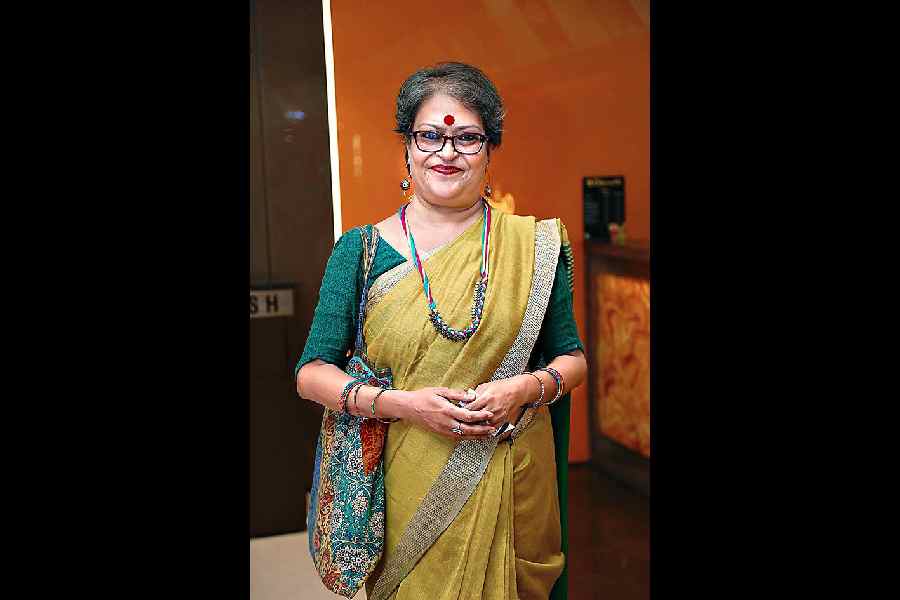
Sudipa Basu
THE SUPPORT THE STAGE NEEDS
While most theatre people talked about the importance of financers investing in productions, Koushik Sen had a counterpoint. “I just need the support of the people. I don’t need any other support because no other support will be available consistently. We have to support ourselves. Political forces are not interested in theatre. We have to constantly innovate and improvise,” he said.
However, Reshmi Sen stressed on the need for more financers like Bickram Dasgupta from Calcutta Broadway who gave the initial funding for Hamlet. “But they were not involved in creative production. We want such people to come forward and think of theatre. This is an art that needs support,” she said.
While Riddhi mentioned the difference a financer can make, he also shared his straightforward views about government support in this matter. “No government ever supported theatre because theatre always has a stance which is against state machinery; it is not just in Calcutta but throughout the world,” said Riddhi.
Echoing Koushik Sen, Debshankar Halder said, “In Calcutta, theatre can only be saved by its audience. It is not only to buy our tickets but also to appreciate the truth we are showing them. We need an audience that thinks openly and puts those thoughts to work.”
Sudipta emphasised the need for better marketing and the attention of the mass media. “Finance and marketing support is required in the present day scenario to let people know that a show is happening. Mainstream mass media doesn’t discuss theatre regularly to broaden the spectrum that is required,” she said.
“Theatre is a self-sustaining model, so we don’t face any problem other than ill-maintained halls. People who know theatre should be given responsibility to develop the halls,” said Rwitobroto, who loves handling backstage other than exploring different roles on stage.
Theatre artistes Shantilal Mukherjee, Sudipa Basu, Kamaleswar Mukherjee, Chandan Sen spoke about the design of theatres.
“More theatres are needed and they should be equipped with the depth of the stage, backstage and acoustics like abroad. It is very difficult to perform in places that are compromised. Better watching conditions are required. Definitely some government support would be good for theatre to prosper. The most important thing in today’s market is promotion that needs to be taken care of by financers. Only with that the quality of theatre and quantity of theatre would be better in future,” said Kamaleswar, who has been on and off associated with theatre for over 35 years now.
“Now, for a good theatre the minimum ticket price is Rs 100 and maximum is Rs 500. And despite the price, full house is happening. But if the hall is not good, it is not right,” said Sudipa.
Reflecting on the kind of work happening in the intimate theatre space, Suman Mukhopadhyay said: “Not everything is a two-minute reel; theatre is compelling one to sit with patience for some hours. That’s the difference we are trying to create. We have to create off the centre. We need to create more interesting spaces of performances. Theatre has to reach out.” And going by appearances, it is doing just that.
